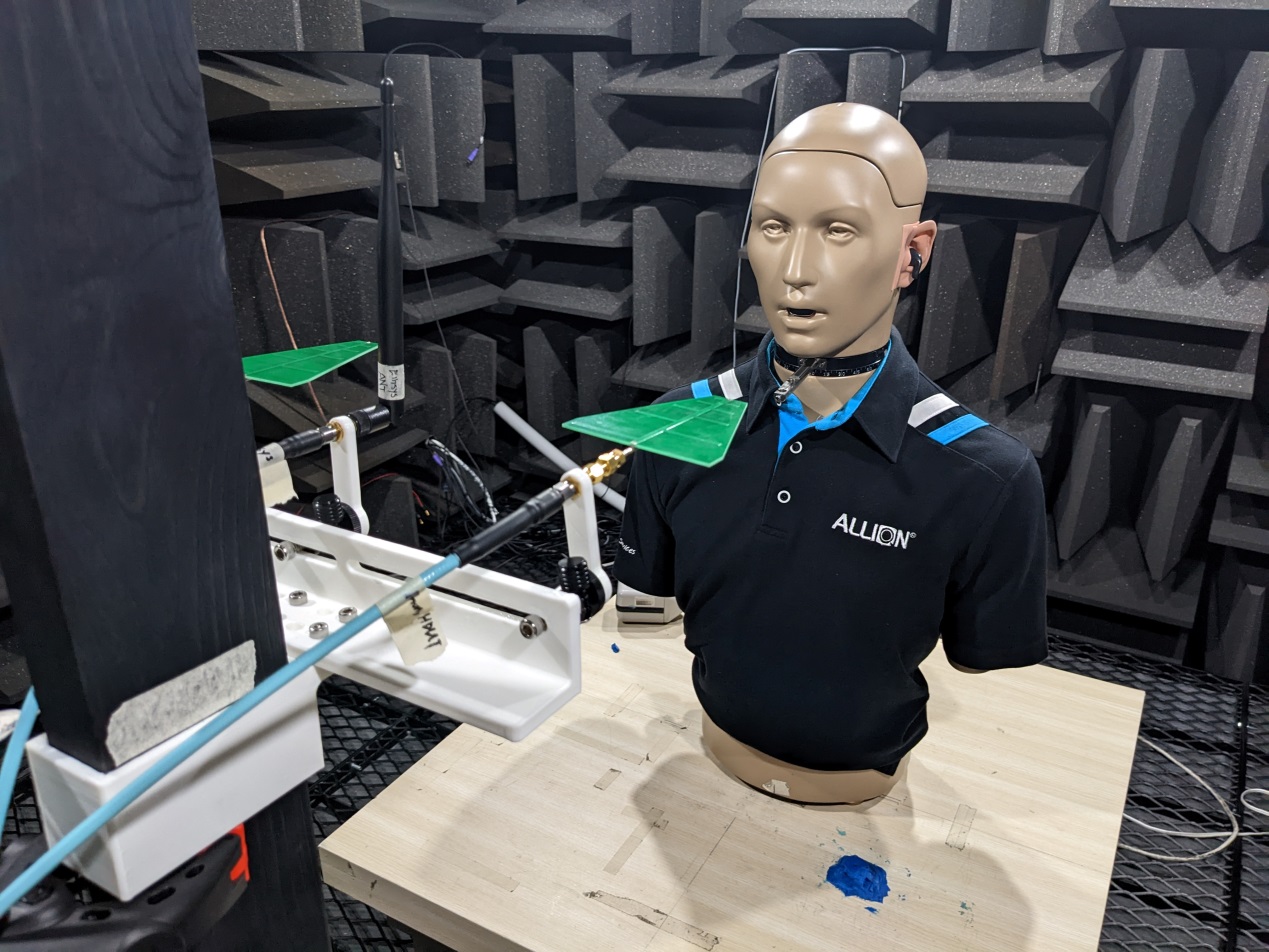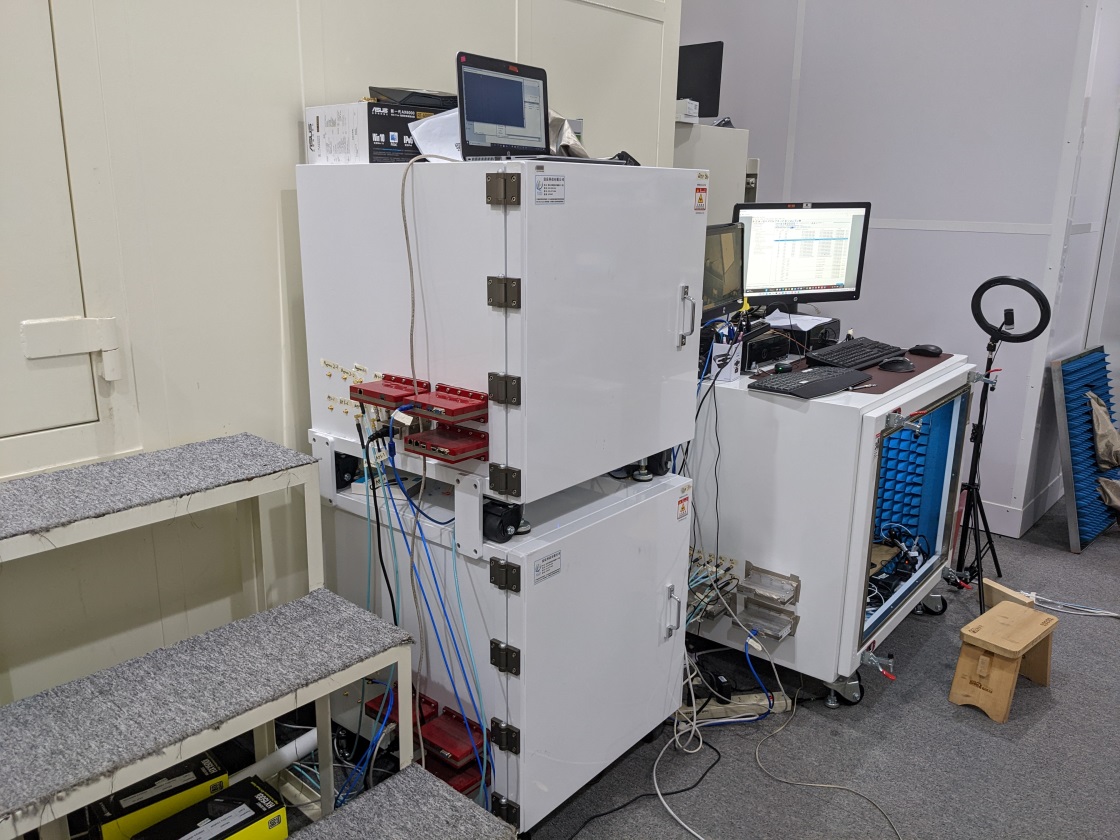Allion Labs | Greg Tsai
Previously, we introduced the voice quality measurement standard POLQA. In this article, we will demonstrate its real-life applications and use cases.
Allion’s Acoustic and RF departments have jointly created an evaluation environment for the impact of radio interference on the voice quality of Bluetooth headsets. As can be seen in the picture below, Allion has all the tools and equipment necessary to perform the assessment.

Photo of the anechoic room, HATS and RF antenna

RF shielding box
As mentioned previously, voice quality can be assessed both on the sending path (microphone reception of the DUT) and the receiving path (headphone speaker broadcast).
In our case, our “device under test” (DUT) is a Bluetooth wireless headset. The process is illustrated in the diagram below, which is adapted from Audio Precision’s TN120 technical paper.
We first use the built-in Reference Wave File of Audio Precision as the audio source signal for testing. Then, for the playback, we broadcast it through a HATS built-in “artificial mouth” using the unbalanced analog output of the Audio Analyzer (APx585).
The sound is then picked up by the DUT’s microphone, before being transmitted back to Computer One (PC1) via Bluetooth. Next, we establish communication with Computer Two (PC2) through Microsoft Teams, before connecting PC2’s headset jack to the unbalanced analog input of the audio analyzer (APx585), thus completing the entire test.
The process includes not only evaluating conventional connection strength influences such as codecs, but also RF interference and the adjustable PC1 antenna transceiver strength.
The Allion lab’s professional setup, as shown in the picture below, allows us to create the desired RF wireless interference intensity and RF antenna strength.
By adjusting the antenna strength of PC1, we can simulate the different voice qualities of the DUT headset microphone under varied communication ranges.
The below table shows the different voice qualities (MOS-LQO) of the headset microphone under varied RF conditions:
| MOS-LQO (Sending Path) | Headset DUT A | Headset DUT B | |
| RF Interference: Strong | Near Range | 1.3 | 3.3 |
| Medium Range | 1.22 | 3.2 | |
| Far Range | 1.03 | 3 | |
| RF Interference: Medium | Near Range | 2.5 | 3.9 |
| Medium Range | 2.4 | 3.7 | |
| Far Range | 2.2 | 3.5 | |
| RF Interference: Weak | Near Range | 3.1 | 4.3 |
| Medium Range | 3 | 4.2 | |
| Far Range | 2.8 | 4 | |
In addition, we are also able to evaluate the voice quality of the headset’s speaker. (The architecture diagram below is based on Audio Precision’s TN120 technical paper).
Below are the voice quality ratings (MOS-LQO) for the headset’s speaker under different RF conditions.
| MOS-LQO (Receiving Path) | Headset DUT A | Headset DUT B | |
| RF Interference: Strong | Near Range | 3.44 | 3.03 |
| Medium Range | 3.16 | 2.9 | |
| Far Range | 1.93 | 2.81 | |
| RF Interference: Medium | Near Range | 3.8 | 3.51 |
| Medium Range | 3.71 | 3.47 | |
| Far Range | 3.5 | 3.34 | |
| RF Interference: Weak | Near Range | 4.1 | 3.82 |
| Medium Range | 3.92 | 3.78 | |
| Far Range | 3.8 | 3.61 | |
Using these tests, we are able to identify POLQA as a time-saving alternative to manual listening, which makes the evaluation process more efficient for the testing team and the results more objective as well.
A few of the low scores can be attributed to codec quality issues and others to the RF’s anti-jamming capabilities.
Using this system, we can conduct reliable cross-comparisons with other commercially available headsets, thus ensuring quality and determining the positioning of our own products.
Allion certification laboratory is also among the designated third-party labs of the “Accessories Engineered for Intel® Evo™” program. Please do not hesitate to contact us any headset certification related questions.
https://www.intel.com/content/www/us/en/products/systems-devices/laptops/evo/article.html
https://www.allion.com.tw/news-center/intel_bluetooth_accessory_ux_test/

































